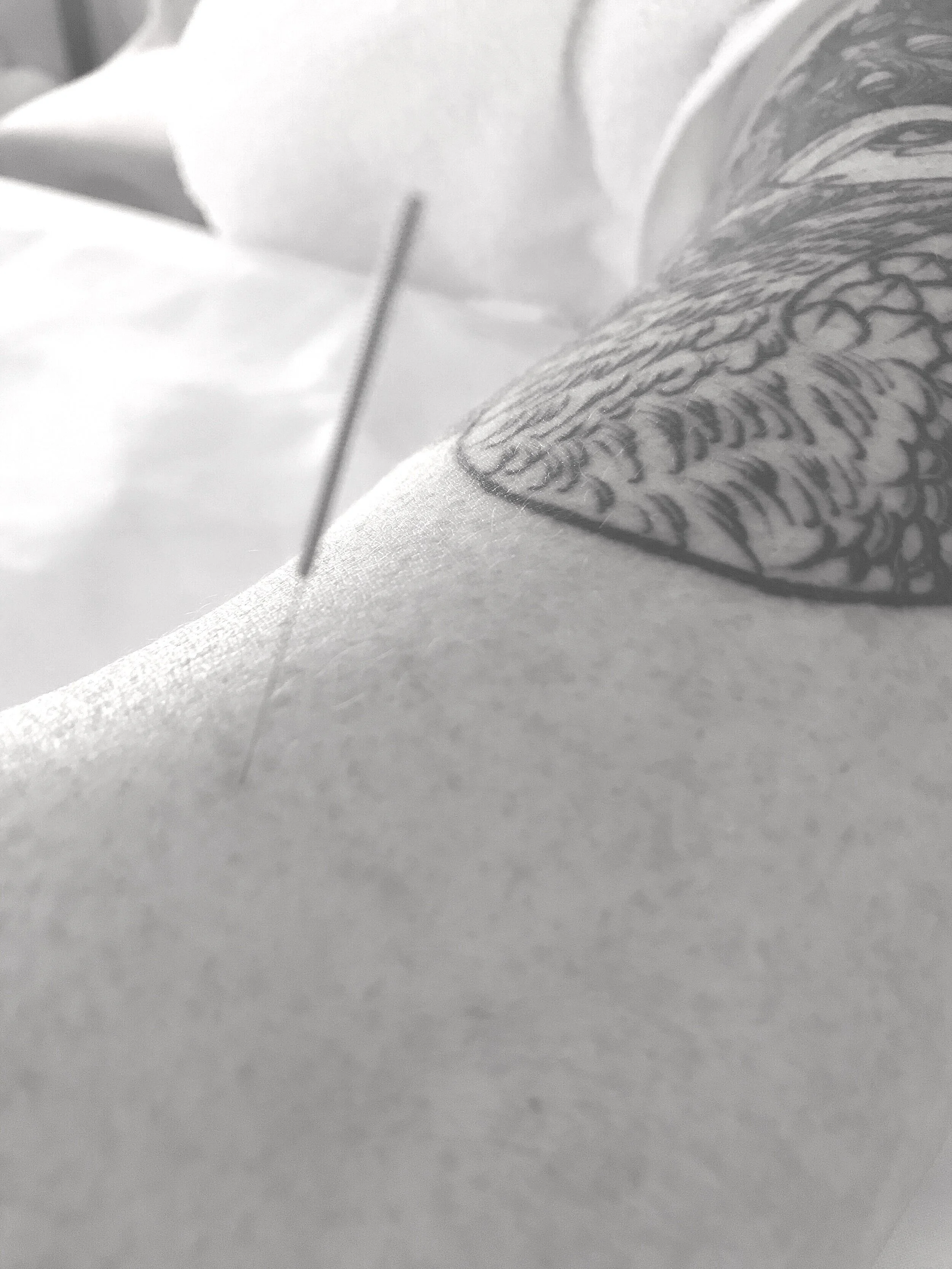What is Acupuncture?
Acupuncture is one of the oldest and most effective healing modalities found in TCM (Traditional Chinese Medicine) that has been in existence for over 4,000 years in China. Today, it can be found all over the world being used by trained and licensed acupuncturists and doctors in hospitals, clinics, wellness centers, professional sports teams, in the military (see battle field acupuncture), community clinics and private practices. Acupuncture can be used as a full-body system or on microcosms of the body (i.e. ear, hand or feet).
In 1997, the U.S. National Institutes of Health (NIH) documented and publicized acupuncture’s safety and efficacy for treating a wide range of conditions. Acupuncture is now covered by many insurance policies and is used most broadly to relieve pain, but can be used for many conditions, as well as preventative medicine and boosting the immune system..
How does it work?
Acupuncture involves the insertion of very fine, sterile needles into specific acu-points on channels known as “meridians.” These meridians flow through and are assigned to specific systems, organs and fascia. Your practitioner will come up with a point prescription and formula based on your diagnosis or health goals. Pressure, heat, or electrical stimulation may further enhance the effects. These needles don’t hurt (because they are thin, unlike hypodermic needles you see at your MD’s office), but will cause a heavy, warming, tingling sensation. If the patient feels any kind of “pinch” or “sticking” feeling, the practitioner should take the needle out and reinsert at a slightly different angle, location or depth. It should not hurt. Don’t ever be afraid to tell your practitioner if the needle(s) is (are) uncomfortable, as they should not be.
Once the acu-points are selected and activated by the needles, a chemical cascade response takes place within the CNS (central nervous system), alerting the brain to release chemical messengers. These chemical messengers respond by sending the needed actors such as endorphins, norepinephrine, and enkephalin through the body. In some cases, vasodilation will also affect blood flow, muscle contraction and increase or decrease hormone levels as the body works towards homeostasis (balance). Natural pain killers (NPK’s) are also activated decreasing inflammation in the body and causing patients to experience a feeling of calm and relaxation.
A patient will lay on a comfortable, heated table anywhere between 25-45 minutes. The practitioner then leaves the room for you to relax. Many fall asleep, as it is a relaxing experience for most.
Modern research has demonstrated acupuncture’s effects on the nervous system, endocrine and immune systems, cardiovascular system, and digestive system. By stimulating the body’s various systems, acupuncture can help to resolve pain, and improve sleep, digestive function, and sense of well-being.
Will it work for me?
Hundreds of clinical studies on the benefits of acupuncture show that it successfully treats conditions ranging from musculoskeletal problems (back pain, neck pain, and others) to nausea, migraine headache, anxiety, depression, insomnia, and infertility.
Case-controlled clinical studies have shown that acupuncture has been an effective treatment for the following diseases, symptoms or conditions:
Allergic rhinitis (including hay fever)
Biliary colic
Carpel Tunnel
Depression (including depressive neurosis and depression following stroke)
Dysentery, acute bacillary
Dysmenorrhoea, primary
Epigastralgia, acute (in peptic ulcer, acute and chronic gastritis, and gastrospasm)
Facial pain (including craniomandibular disorders)
Headache
Hypertension, essential
Hypotension, primary
Induction of labor
Knee pain
Leukopenia
Low back pain
Malposition of fetus, correction
Morning sickness
Nausea and vomiting
Neck pain
Pain in dentistry (including dental pain and temporomandibular dysfunction)
Periarthritis of shoulder
Postoperative pain
Renal colic
Rheumatoid arthritis
Sciatica
Sprain
Stroke
Tendonitis
Tennis elbow
The following diseases, symptoms or conditions have limited but probable evidence to support the therapeutic use of acupuncture:
Abdominal pain (in acute gastroenteritis or due to gastrointestinal spasm)
Acne vulgaris
Alcohol dependence and detoxification
Bell’s palsy
Bronchial asthma
Cancer pain
Cardiac neurosis
Cholecystitis, chronic, with acute exacerbation
Cholelithiasis
Competition stress syndrome
Craniocerebral injury, closed
Diabetes mellitus, non-insulin-dependent
Earache
Epidemic haemorrhagic fever
Epistaxis, simple (without generalized or local disease)
Eye pain due to subconjunctival injection
Female infertility
Facial spasm
Female urethral syndrome
Fibromyalgia and fasciitis
Gastrokinetic disturbance
Gouty arthritis
Hepatitis B virus carrier status
Herpes zoster (human (alpha) herpesvirus 3)
Hyperlipaemia
Hypo-ovarianism
InsomniaLabour pain
Lactation, deficiency
Male sexual dysfunction, non-organic
Ménière disease
Neuralgia, post-herpetic
Neurodermatitis
Obesity
Opium, cocaine and heroin dependence
Osteoarthritis
Pain due to endoscopic examination
Pain in thromboangiitis obliterans
Polycystic ovary syndrome (Stein-Leventhal syndrome)
Post-extubation in children
Postoperative convalescence
Premenstrual syndrome
Prostatitis, chronic
Pruritus
Radicular and pseudoradicular pain syndrome
Raynaud syndrome, primary
Recurrent lower urinary-tract infection
Reflex sympathetic dystrophy
Retention of urine, traumatic
Schizophrenia
Sialism, drug-induced (excessive salivation)
Sjögren syndrome
Sore throat (including tonsillitis)
Spine pain, acute
Stiff neck
Temporomandibular joint dysfunction
Tietze syndrome
Tobacco dependence
Tourette syndrome
Ulcerative colitis, chronic
Urolithiasis
Vascular dementia
Whooping cough (pertussis)
How many treatments will I need?
The frequency and number of treatments differ from person to person. Some people experience dramatic relief in the first treatment. For complex or long-standing chronic conditions, one to two treatments per week for several months may be recommended. For acute problems, usually fewer visits are required, usually eight to ten visits in total. An individualized treatment plan that includes the expected number of treatments will be discussed during your initial visit. Waleli Wellness also offers package plans or an annual membership plan (saving you 40% off all services), accepts HSA and FSA payments, can give you a super bill to submit to your insurance company for reimbursement and discounts to students, active military and veterans and seniors 65 or older.
Ok. Sign me up. What should I wear? How do I prepare?
Please be sure to eat something (light) before you come. Wear loose fitting clothing that allows the practitioner to access your body from your elbows down and your knees down (no tight fitting pants or sports bras, please). Most patients can stay completely dressed if they follow these rules. If the practitioner needs to get to your mid-back, chest or buttocks due to your specific condition and prognosis, you will be provided with a sheet for coverage. Most treatments that involve the back are with the patient face-down on a comfortable heated table (similar to a massage table) that allows you to lay comfortably. A blanket that does not weight on the needles can also be provided if the patient is prone to getting cold.

